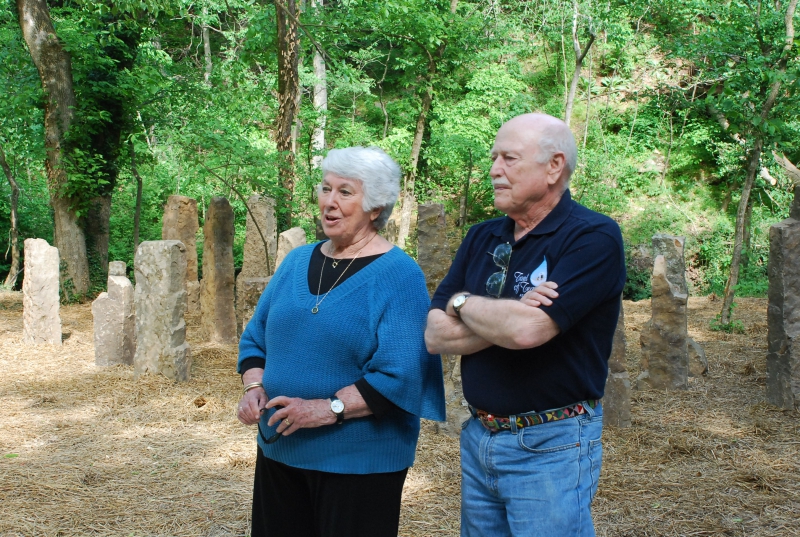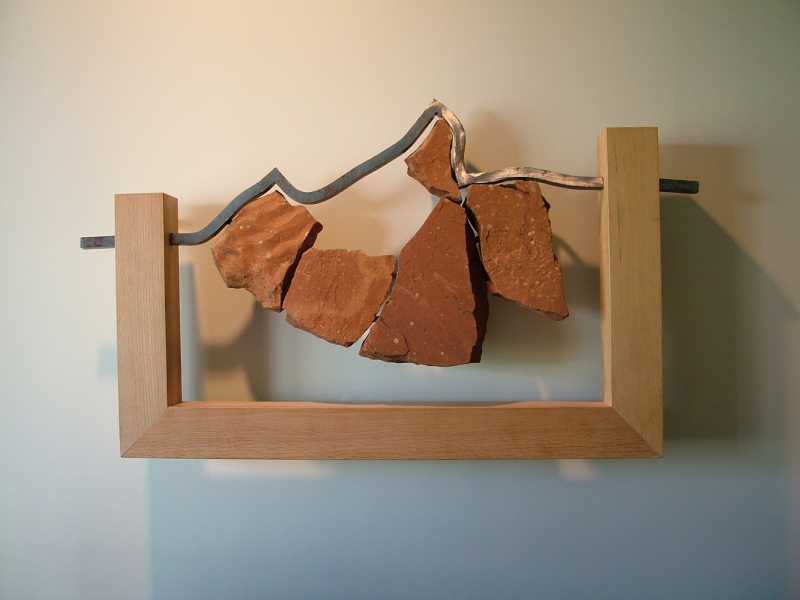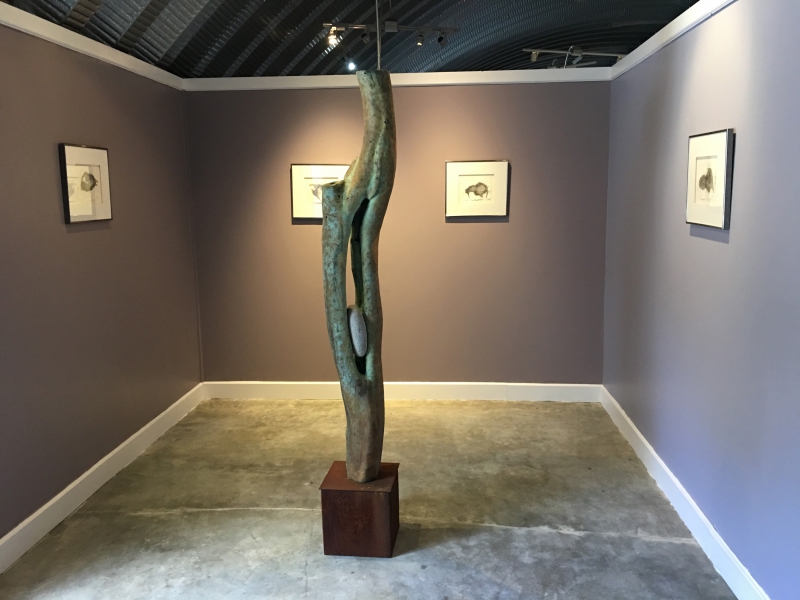By Meg Brazill
The night was clear when artist Pat Musick stepped outside her house in upstate New York to see Skylab 4 making one of its 1,214 orbits around the Earth. Musick watched as the craft flew through the starry sky, a beacon connecting humans with the universe. She mused about the people on board, wondering who they were, and then the station slipped below the horizon and out of view.
The year was 1973 and Musick, an artist who creates two- and three-dimensional work in a variety of media, was completing her master’s in design and a doctorate in philosophy at Cornell University.
Houston, Do You Read Me?
Five years later Musick was teaching art and psychology at the University of Houston when she met retired Marine Col. Gerald “Jerry” P. Carr, a former astronaut, at a small church in Webster, Texas.
“There was a Presbyterian yenta in the choir and she decided we needed to get together,” Musick says.
It turned out that Musick had met her spaceman: Carr, commander of Skylab 4, had been on the space mission sweeping in orbit above Musick’s house that night in 1973. (With him had been science pilot Edward G. Gibson and pilot William R. Pogue, all three on their only space flight and Skylab’s final mission.)
Musick and Carr’s serendipitous meeting was just the beginning. Two years later the couple were married. They’ve been together more than 35 years, the most recent 10 of which they’ve been making their home in Manchester Center. In addition to a life they make art together, synthesizing their ideas and philosophies visually. That synthesis takes up Musick’s concern with the tension between man and the natural environment, and Carr’s galactic viewpoint.
Their shared insight: Earth is fragile, humans are responsible for it as caretakers, the natural world is immensely beautiful, and peace and harmony are integral to our well-being.
Musick says she’s been making art since she was 4.
Carr entered military service when he was 17. NASA tapped him as one of 19 astronauts in April 1966.
“Because of my space flight I had the chance to see the Earth and it moved me profoundly,” Carr says. “The beauty of the Earth. From a distance you can see a little blue ’fuzz’ surrounding the Earth, which is the atmosphere.” Carr describes that “fuzz” in relative terms as “about as thin and fragile as the skin of an apple. And that’s what protects us from everything. It brings up a lot of concern about the Earth.”
When the two met, the combination of science and art didn’t immediately take hold.
“Over time, however, we began to put our creative and scientific interests together,” Musick says. “My art became more environmental and Jer’ learned more about art and creativity.”
Carr became increasingly involved in the construction of the artwork, and more of the materials came from the earth. He’s been photographing Musick’s work for decades.
“Jerry later confided to me that his favorite activity on Skylab was to look out the dining room window and watch the Earth pass by at six miles per second. He and his crew studied the Earth and the effects of pollution on the planet,” his wife says. “I think it was at these moments that he found himself becoming an instant environmentalist.”

“Gateposts ? 4, 5, 6,” by Pat Musick (54 in. x 52 in. x 4 in.; canvas, wood, steel, acrylic) at the Helmholtz Gallery in Manchester.
When Carr met Musick he had retired from NASA and was working as an engineering consultant. She was teaching. And when they married — in a second marriage for both — they had an instant family: nine children and three grandchildren. In 1985 the couple moved to Northwest Arkansas, which put them near a university and an airport, and near nature, and equidistant to their kids, who were all over the country.
“We wanted to travel and [Jerry’s] work gave us some wonderful opportunities to travel abroad,” Musick says.
Going Country
Musick referred to herself at the time as a city girl but Arkansas changed all that. Their new home put the couple in touch with nature. Musick says she found it a continuing source of inspiration. The two roamed their property in search of natural materials. Musick works with stone, wood, and beeswax, which reflect the natural world; and steel, canvas, and paper, the human world.
At other times, Carr would find something interesting and photograph it or get Musick to go out and see it — like the turkey he discovered, and her nearby nest of eggs, which became the inspiration for Musick’s series “Nest.”
“We’d find sections of dead tree trunks so we’d bring back a hollowed-out form,” Carr says.
During a hurricane, several trees were uprooted. Afterward, as they’d walk the woods or drive down the road, there were gigantic root balls, taller than Carr. The couple filled trash barrels with cut roots.
“We didn’t always carry a chainsaw but we always had loppers,” Carr says. “We never had to harvest any trees for firewood either. Mother Nature does the work.”
One year a wildfire took its toll, decimating part of their forest.
“I was so affected by the disasters I felt like the world was coming to an end,” Musick says. But then, “the next year there were little green shoots coming up from the burned forest floor.” Living with nature provided life lessons such as patience and hope.
They lived there for 22 years before moving to Manchester Center in 2006, where they still make their home. Their studio is in nearby Sunderland.
Astronaut, Assistant, Artist
When Carr retired from consulting, he became a studio assistant for his wife.
“His responsibilities grew and grew until he became an artist,” Musick said. “So the second half of the story is working to express our joint concern.” Although Carr downplays his role, his contributions included fabricating metal and wood pieces over the years, work integral to Musick’s vision.
Now they’re getting ready for two big projects, one of which is a 25-year retrospective (1990-2015) of Musick’s work. Much of that output dates to a period before Carr logged any involvement. He’s more than involved now, however, as he is preparing to ship the work to Texas, where the show is to be mounted at the Sculpture Ranch & Galleries in Johnson City.
“The property used to be part of the LBJ ranch. For the past 20 years or so, it’s been a huge outdoor sculpture center,” Carr explains. “And what was [LBJ’s] airplane hangar, an 8,000 square-foot space, has been turned into indoor galleries.”
This year, the owners will exhibit solo shows in the indoor space so they can concentrate on an individual artist’s body of work for six months.
“Pat will be the first artist to show under the new program,” Carr notes. Her exhibition will run from September through March.
“Over these two and a half decades I’ve explored two- and three-dimensions, wall sculpture, and off-the-wall sculpture, to express my personal message,” Musick says. “I began as a painter and transitioned to wall sculpture, then freestanding works.” Her art shifted from expressionistic to abstract to conceptual with a gradual, steady reduction to simpler elements.
It’s about “care and concern for the Earth, and both the human and the animal world, and the need to live together harmoniously. The environment, humans living together and protecting the environment,” Musick says. And Carr concurs: “We have a concern about what’s happening to the Earth and what we can do to live harmoniously and to mitigate what’s going on in our Earth.”
Bridging the Years
This summer the couple plan to travel to Crystal Bridges Museum of American Art in Bentonville, Ark., to celebrate Musick’s 90th birthday and to visit her commissioned installation, “A Place Where They Cried,” a 35-foot multi-unit stone sculpture along 65 feet of a walking trail that extends out of the woods on the museum’s extensive grounds. Represented in the piece are male, female, and childlike forms recalling the Cherokee, Chickasaw, Choctaw, Muscogee, Creek and Seminole people who traveled through Arkansas as part of the Trail of Tears forced migration in 1837-39.
An estimated 4,000 Native Americans died on the trail.
In an Art Daily profile, Musick says “the museum, dedicated to collecting American art, will provide a valuable perspective on art history and will be a cultural enrichment to all who visit. To have the honor of installing a sculpture in such a setting is a humbling experience.”
Talkin’ ’Bout the Next Generation
Looking ahead, Carr says, the couple’s biggest mutual concern is about humanity’s future on the Earth.
“We’re concerned about the data that’s coming out and we don’t profess to be able to say anything much about the scientific aspect.”
The couple agree, too, that Vermont provides unique opportunities that they could not find in very many places — for example, opportunities for sustainable living, including local sourcing of food.
“Vermont is so beautifully conscious of sustainable living,” Carr adds.
“We have eight great-grandchildren and we’re very concerned about the world we’ll leave them,” Carr says. “[We] hope for a world that has cleaner power and cleaner energy sources. We feel lucky to be in a place where this concern can be researched, studied, and acted upon.”
Pat Musick’s work is represented in the collections of more than 100 museums and public spaces in the United States, Canada, Mexico, and Europe, and can regularly be seen in Southern Vermont at Helmholz Fine Art in Manchester Center, 442 Depot St.; 802-855-1678; helmholzfineart.com. For more information, visit http://www.camusart.com.
























































